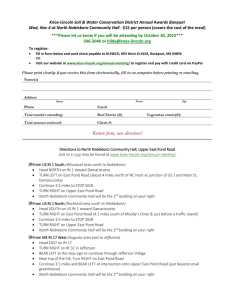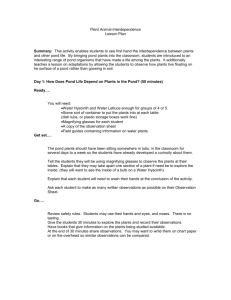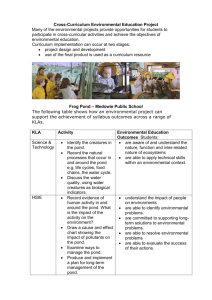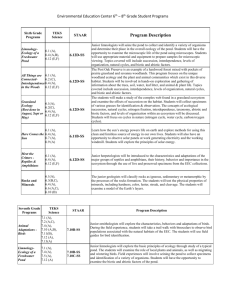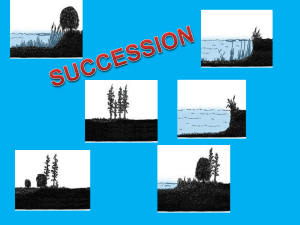High School Program Descriptions and TEKS Correlations
advertisement
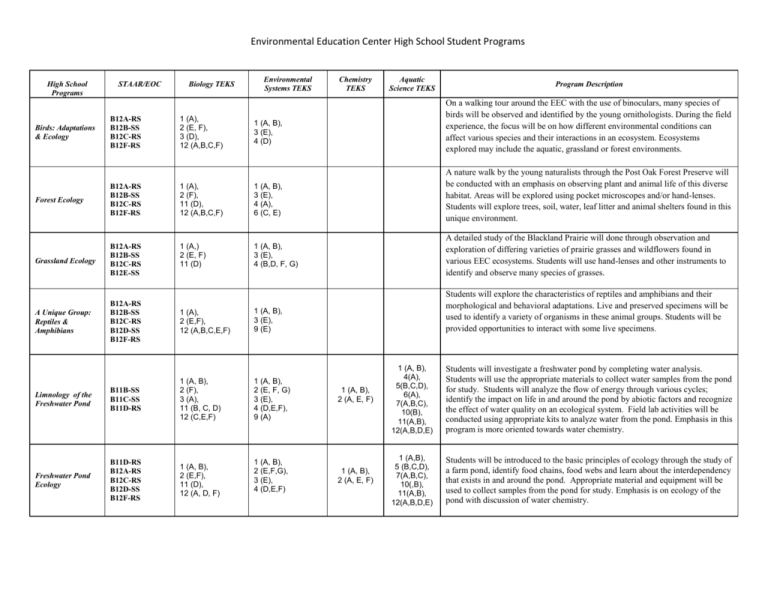
Environmental Education Center High School Student Programs High School Programs STAAR/EOC Biology TEKS Environmental Systems TEKS Birds: Adaptations & Ecology B12A-RS B12B-SS B12C-RS B12F-RS 1 (A), 2 (E, F), 3 (D), 12 (A,B,C,F) 1 (A, B), 3 (E), 4 (D) Forest Ecology B12A-RS B12B-SS B12C-RS B12F-RS 1 (A), 2 (F), 11 (D), 12 (A,B,C,F) 1 (A, B), 3 (E), 4 (A), 6 (C, E) Grassland Ecology B12A-RS B12B-SS B12C-RS B12E-SS 1 (A,) 2 (E, F) 11 (D) 1 (A, B), 3 (E), 4 (B,D, F, G) A Unique Group: Reptiles & Amphibians B12A-RS B12B-SS B12C-RS B12D-SS B12F-RS B12F-RS 1 (A), 2 12(E,F), (A,B,C, E, F) 12 (A,B,C,E,F) Limnology of the Freshwater Pond B11B-SS B11C-SS B11D-RS 1 (A, B), 2 (F), 3 (A), 11 (B, C, D) 12 (C,E,F) Freshwater Pond Ecology B11D-RS B12A-RS B12C-RS B12D-SS B12F-RS 1 (A, B), 2 (E,F), 11 (D), 12 (A, D, F) Chemistry TEKS Aquatic Science TEKS On a walking tour around the EEC with the use of binoculars, many species of birds will be observed and identified by the young ornithologists. During the field experience, the focus will be on how different environmental conditions can affect various species and their interactions in an ecosystem. Ecosystems explored may include the aquatic, grassland or forest environments. A nature walk by the young naturalists through the Post Oak Forest Preserve will be conducted with an emphasis on observing plant and animal life of this diverse habitat. Areas will be explored using pocket microscopes and/or hand-lenses. Students will explore trees, soil, water, leaf litter and animal shelters found in this unique environment. A detailed study of the Blackland Prairie will done through observation and exploration of differing varieties of prairie grasses and wildflowers found in various EEC ecosystems. Students will use hand-lenses and other instruments to identify and observe many species of grasses. Students will explore the characteristics of reptiles and amphibians and their morphological and behavioral adaptations. Live and preserved specimens will be used to identify a variety of organisms in these animal groups. Students will be provided opportunities to interact with some live specimens. 1 (A, B), 3 (E), 9 (E) 1 (A, B), 2 (E, F, G) 3 (E), 4 (D,E,F), 9 (A) 1 (A, B), 2 (E,F,G), 3 (E), 4 (D,E,F) Program Description 1 (A, B), 2 (A, E, F) 1 (A, B), 2 (A, E, F) 1 (A, B), 4(A), 5(B,C,D), 6(A), 7(A,B,C), 10(B), 11(A,B), 12(A,B,D,E) Students will investigate a freshwater pond by completing water analysis. Students will use the appropriate materials to collect water samples from the pond for study. Students will analyze the flow of energy through various cycles; identify the impact on life in and around the pond by abiotic factors and recognize the effect of water quality on an ecological system. Field lab activities will be conducted using appropriate kits to analyze water from the pond. Emphasis in this program is more oriented towards water chemistry. 1 (A,B), 5 (B,C,D), 7(A,B,C), 10(,B), 11(A,B), 12(A,B,D,E) Students will be introduced to the basic principles of ecology through the study of a farm pond, identify food chains, food webs and learn about the interdependency that exists in and around the pond. Appropriate material and equipment will be used to collect samples from the pond for study. Emphasis is on ecology of the pond with discussion of water chemistry.




